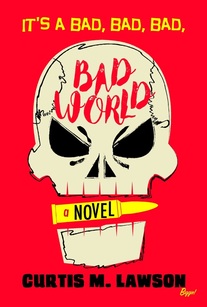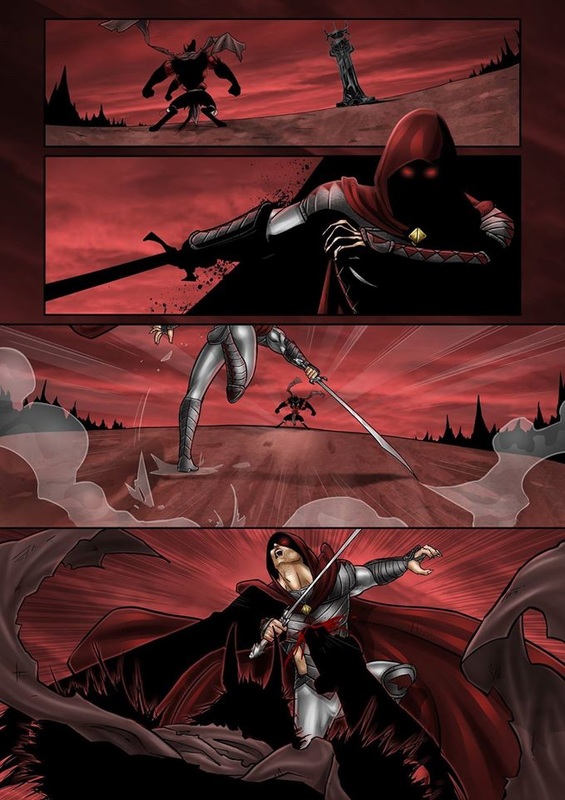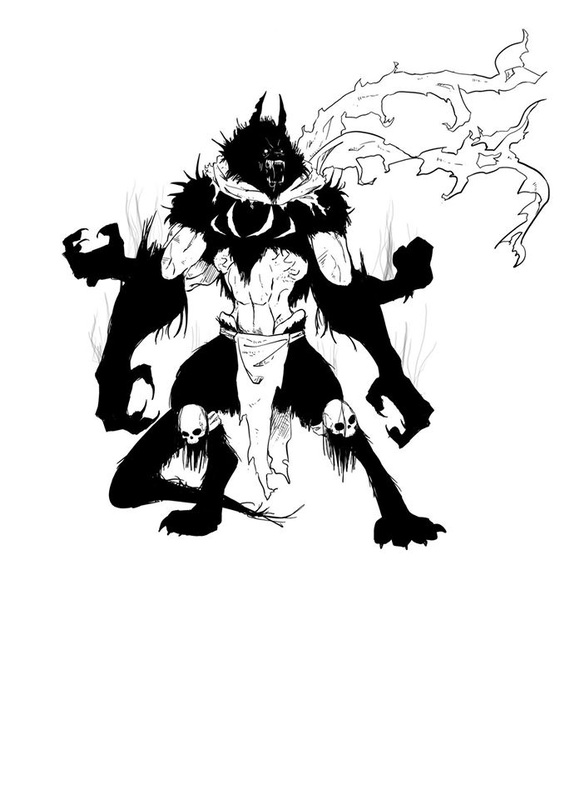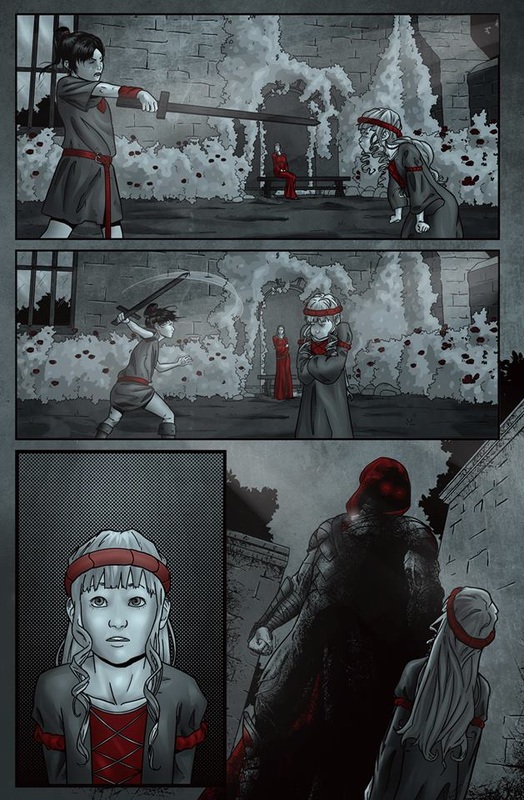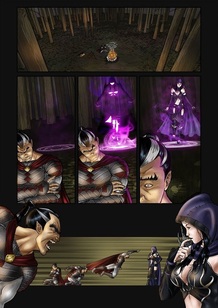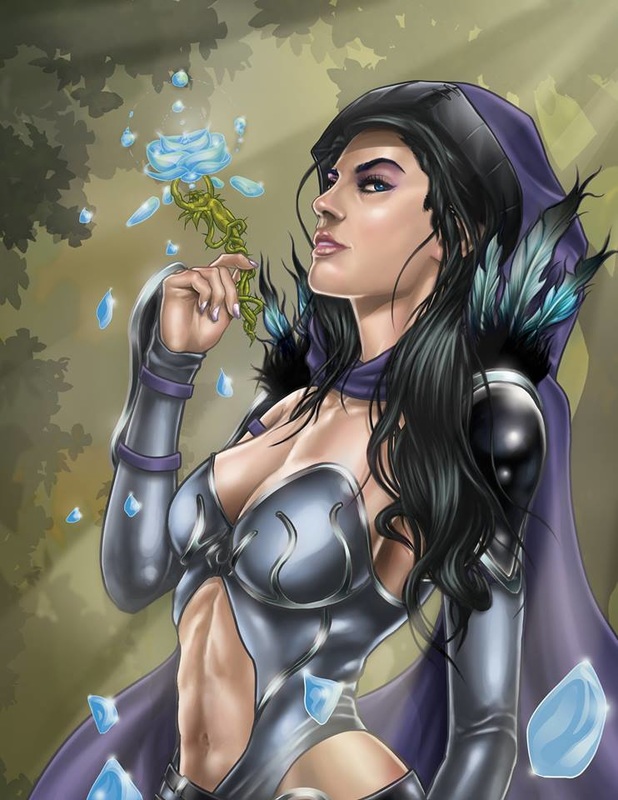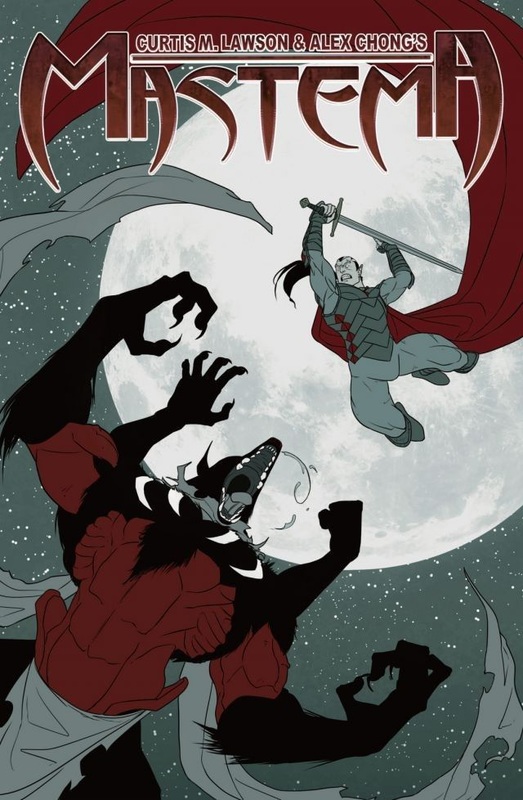Interview with...
CURTIS LAWSON
CURTIS LAWSON'S MASTEMA SHOWCASES A MERCENERY HIRED BY CLERGY TO DO THEIR DIRTY WORK. WHY WOULD HOLY MEN HIRE A DEMON WARRIOR? CURTIS RECENTLY SPOKE WITH CBI ABOUT HIS BOOK AND ITS ORIGINS...
JMH: What is Mastema?
CML: Mastema is a dark fantasy story about a once a holy knight whose soul was tainted by the essence of the demon known as Fenris. Mastema's painful origin resurfaces as Fenris hunts him down to reclaim its lost power. Mastema is forced to align himself with his most hated enemy, the sorceress who stole his humanity, in order to survive.
JMH: Can you describe the world/universe it’s from?
CML: The world surrounding Mastema is one of feudal kingdoms, petty warlords, the darkest sorceries, and religious zealotry. It could be called sword and sorcery, but there are subtle elements of modern weaponry and technology fused within the mostly primitive world. Crusading knights wield swords and guns against deadly necromancers and creatures from beyond the mortal world, while the common folk are left as collateral damage.
The lore in the book is drawn from the darker parts of Norse, Celtic, and Christian mythologies. The aesthetic of the gods and their temples is more akin to that of ancient Rome however.
JMH: Does Mastema have supporting characters and if so can you tell CBI about them?
CML: The supporting characters are extremely important in Mastema, and in some ways they are more fleshed out than the title character.
Most important amongst the supporting characters would be Luedke, the sorceress who used her magic to change the knight, Conrad Bellefont into the demonic mercenary, Mastema. She sees herself as Mastema’s lover, mentor, and mother. While Mastema is a raging beast of masculine energy, desperately trying to keep himself in check, Luedke is his direct opposite. She is sexy, eloquent, dangerous, and unchained by ideas such as morality. She is the essence of feminine power when wielded without conscience.
Darius is the second most important supporting character. Once a killer for hire, he is now a holy assassin in the service of the god of Justice. He is relentless, and with singular purpose. In many ways he represents who Mastema was before being infused with Demonic power.
Last on the list is Fenris. Fenris is incarnate rage and hunger in the shape of a four-armed werewolf. Nico did some cool things with the design on our big antagonist. You can see there are stripes in its fur that match up to the streaks of white in Mastema’s hair. The black on his fur is completely pitch, and looks more like solid shadow than anything organic. Lastly, the exposed flesh on the demon is the same color red as Mastema’s cloak and parts of his armor.
JMH: Was Mastema inspired by anything from your past or real life experiences?
CML: Define real life, ha ha. A lot in Mastema was inspired by tabletop role playing sessions I’ve had over the years. The character of Mastema loosely based on a character from a D&D game that I ran about ten years ago. When it was all said and done, I took little from those game sessions, save the concept of his look, his powers, and the name.
The bigger part of the book that draws from real life are some of the emotions in it. A lifetime of bad relationships with women left me with some bitterness and conflicting views. Up until I met my wife, I went through a long period of having no serious relationships because I couldn’t connect with or trust the women I met. I used the character of Luedke to try and sort out my issues with women. I combined all the things that I loved and hated about the feminine (be they fair assessments or not) into this powerful, beautiful, amoral character of Luedke. I’m not sure why or how, but it helped me let go of a lot of my emotional and philosophical baggage by expressing myself through her.
Additionally, the character of Mastema helped me deal with a lot of other personal issues I had been coming to grips with for several years. Before I started writing seriously I was playing in metal bands, and kind of defined myself through that. I had a pretty strong idea of how the world worked, and what I believed my place in it was. Then all of a sudden the rug got pulled out from under me. An enemy I made in a pretty popular metal band left me feeling disenfranchised with the whole scene. My band unceremoniously fired me, and long time friendships fell apart.
At the same time my philosophical view of the world came into question. All this happened within a very short time period and I was left feeling kind of shattered. I didn’t know who I was anymore, and it took a long time for me to figure it out. That’s where the concept of the knight whose soul is broken and remade into something horrific came from. It was a way to face my own failures, and move on with becoming who I needed to be.. I know that all sounds kind of silly and melodramatic, but it’s the truth
JMH: Do your stories carry a message to the readers?
CML: I try not to get didactic or preachy. My number one goal is to entertain. That being said, I think my personal values and beliefs shine through from time to time. I wouldn’t say they are messages, so much as themes in my work. Most of my stories convey my own distrust for religion. My protagonists are closer to the classical, pre-Christian idea of heroism than the softer, moralistic hero archetype of modern times.
I think the value that I put on intellect shines through in my stories as well. While my work is often violent, I try to show that the mind is a more powerful weapon than the sword. The most powerful characters in my stories are sorcerers, scientists, and strategists.
JMH: Talk about the creative team involved with Mastema …
CML: Alex Chong was the original artist on the book. He designed Mastema’s unique armor and the feral details of the character based off of my loose notes. Alex and I did a short Mastema story together called A Devil’s Mercy, which appears in the back of the graphic novel. He did all the artwork and colors on that, but when it came time to do the big story he simply didn’t have the time to devote to it.
Looking for someone to replace Alex, I came into contact with Nico Leon through a mutual acquaintance. I offered Nico the job, his first in comics, and he knocked it out of the park. Per my instructions he left the design of Mastema intact, but he scrapped Alex’s other concept pieces and redesigned the supporting characters with a more grounded aesthetic that better fit the tone of the book. He really breathed life into the world. After Mastema we pitched one other book that got rejected, and Nico decided to focus on breaking in at Marvel. He’s now taking over art duties on Spider-Man! It couldn’t happen to a better, more deserving guy.
With the line art in good hands, I went to a creator connection panel at NYCC a few years back looking for a colorist. It was there that I met Angel Aviles, who blew me away with his sample pieces. Angel joined the team and he did an incredible job. He even did a gorgeous digital painting of Luedke as a promotional piece once the book was finished.
JMH: Will Mastema be released in digital format, web comic, or print?
CML: Mastema has been on Comixology for some time now, but the print book just hit shops in June. It was my first book with Diamond distribution so I was pretty psyched when friends in other states started sending me pics from their local comic shops!
JMH: Where can fans get a hold of Mastema?
CML: Mastema is available through your local comic shop. If they don’t have it in stock, they can order it for you. Soon I’ll be selling autographed copies on my website, but I don’t have an exact date on that yet. And if they want digital, it is available through comixology.
JMH: How can fans contact you?
CML: I’m pretty accessible and I love hearing from fans and fellow creators. My facebook author page is https://www.facebook.com/curtismlawson . People can tweet to me @C_lawson , or email me directly to [email protected]
I’m serious too, I want to hear from you!
JMH: Finally, is there anything coming up in further Mastema stories, or other projects you want people to know about?
CML: Nothing more for Mastema at the moment, though I would love to write more for the character if the right circumstances arose. I sold the rights for the character to Arcana, so I guess the ball is in their court. If they wanted to do something further I would be thrilled to be involved.
As for other projects, I did just release my second prose novel, It’s A Bad, Bad, Bad ,Bad World. The story is pretty wild, full of lunatic nuns, professional sadists, serial killers in love, and inept occultists. Honestly, I think it’s the best thing I have written to date.
The cover is gorgeous and was done by James Biggie of IDW fame. My friend, an artist and musician who goes by the name Monastery, did the ink illustrations on the inside of the book. There are twenty illustrations in all, one for each chapter. I feel the art work really adds an extra dimension to the reader experience.
JMH: Curtis, all the best!
CML: THANK YOU!
CML: Mastema is a dark fantasy story about a once a holy knight whose soul was tainted by the essence of the demon known as Fenris. Mastema's painful origin resurfaces as Fenris hunts him down to reclaim its lost power. Mastema is forced to align himself with his most hated enemy, the sorceress who stole his humanity, in order to survive.
JMH: Can you describe the world/universe it’s from?
CML: The world surrounding Mastema is one of feudal kingdoms, petty warlords, the darkest sorceries, and religious zealotry. It could be called sword and sorcery, but there are subtle elements of modern weaponry and technology fused within the mostly primitive world. Crusading knights wield swords and guns against deadly necromancers and creatures from beyond the mortal world, while the common folk are left as collateral damage.
The lore in the book is drawn from the darker parts of Norse, Celtic, and Christian mythologies. The aesthetic of the gods and their temples is more akin to that of ancient Rome however.
JMH: Does Mastema have supporting characters and if so can you tell CBI about them?
CML: The supporting characters are extremely important in Mastema, and in some ways they are more fleshed out than the title character.
Most important amongst the supporting characters would be Luedke, the sorceress who used her magic to change the knight, Conrad Bellefont into the demonic mercenary, Mastema. She sees herself as Mastema’s lover, mentor, and mother. While Mastema is a raging beast of masculine energy, desperately trying to keep himself in check, Luedke is his direct opposite. She is sexy, eloquent, dangerous, and unchained by ideas such as morality. She is the essence of feminine power when wielded without conscience.
Darius is the second most important supporting character. Once a killer for hire, he is now a holy assassin in the service of the god of Justice. He is relentless, and with singular purpose. In many ways he represents who Mastema was before being infused with Demonic power.
Last on the list is Fenris. Fenris is incarnate rage and hunger in the shape of a four-armed werewolf. Nico did some cool things with the design on our big antagonist. You can see there are stripes in its fur that match up to the streaks of white in Mastema’s hair. The black on his fur is completely pitch, and looks more like solid shadow than anything organic. Lastly, the exposed flesh on the demon is the same color red as Mastema’s cloak and parts of his armor.
JMH: Was Mastema inspired by anything from your past or real life experiences?
CML: Define real life, ha ha. A lot in Mastema was inspired by tabletop role playing sessions I’ve had over the years. The character of Mastema loosely based on a character from a D&D game that I ran about ten years ago. When it was all said and done, I took little from those game sessions, save the concept of his look, his powers, and the name.
The bigger part of the book that draws from real life are some of the emotions in it. A lifetime of bad relationships with women left me with some bitterness and conflicting views. Up until I met my wife, I went through a long period of having no serious relationships because I couldn’t connect with or trust the women I met. I used the character of Luedke to try and sort out my issues with women. I combined all the things that I loved and hated about the feminine (be they fair assessments or not) into this powerful, beautiful, amoral character of Luedke. I’m not sure why or how, but it helped me let go of a lot of my emotional and philosophical baggage by expressing myself through her.
Additionally, the character of Mastema helped me deal with a lot of other personal issues I had been coming to grips with for several years. Before I started writing seriously I was playing in metal bands, and kind of defined myself through that. I had a pretty strong idea of how the world worked, and what I believed my place in it was. Then all of a sudden the rug got pulled out from under me. An enemy I made in a pretty popular metal band left me feeling disenfranchised with the whole scene. My band unceremoniously fired me, and long time friendships fell apart.
At the same time my philosophical view of the world came into question. All this happened within a very short time period and I was left feeling kind of shattered. I didn’t know who I was anymore, and it took a long time for me to figure it out. That’s where the concept of the knight whose soul is broken and remade into something horrific came from. It was a way to face my own failures, and move on with becoming who I needed to be.. I know that all sounds kind of silly and melodramatic, but it’s the truth
JMH: Do your stories carry a message to the readers?
CML: I try not to get didactic or preachy. My number one goal is to entertain. That being said, I think my personal values and beliefs shine through from time to time. I wouldn’t say they are messages, so much as themes in my work. Most of my stories convey my own distrust for religion. My protagonists are closer to the classical, pre-Christian idea of heroism than the softer, moralistic hero archetype of modern times.
I think the value that I put on intellect shines through in my stories as well. While my work is often violent, I try to show that the mind is a more powerful weapon than the sword. The most powerful characters in my stories are sorcerers, scientists, and strategists.
JMH: Talk about the creative team involved with Mastema …
CML: Alex Chong was the original artist on the book. He designed Mastema’s unique armor and the feral details of the character based off of my loose notes. Alex and I did a short Mastema story together called A Devil’s Mercy, which appears in the back of the graphic novel. He did all the artwork and colors on that, but when it came time to do the big story he simply didn’t have the time to devote to it.
Looking for someone to replace Alex, I came into contact with Nico Leon through a mutual acquaintance. I offered Nico the job, his first in comics, and he knocked it out of the park. Per my instructions he left the design of Mastema intact, but he scrapped Alex’s other concept pieces and redesigned the supporting characters with a more grounded aesthetic that better fit the tone of the book. He really breathed life into the world. After Mastema we pitched one other book that got rejected, and Nico decided to focus on breaking in at Marvel. He’s now taking over art duties on Spider-Man! It couldn’t happen to a better, more deserving guy.
With the line art in good hands, I went to a creator connection panel at NYCC a few years back looking for a colorist. It was there that I met Angel Aviles, who blew me away with his sample pieces. Angel joined the team and he did an incredible job. He even did a gorgeous digital painting of Luedke as a promotional piece once the book was finished.
JMH: Will Mastema be released in digital format, web comic, or print?
CML: Mastema has been on Comixology for some time now, but the print book just hit shops in June. It was my first book with Diamond distribution so I was pretty psyched when friends in other states started sending me pics from their local comic shops!
JMH: Where can fans get a hold of Mastema?
CML: Mastema is available through your local comic shop. If they don’t have it in stock, they can order it for you. Soon I’ll be selling autographed copies on my website, but I don’t have an exact date on that yet. And if they want digital, it is available through comixology.
JMH: How can fans contact you?
CML: I’m pretty accessible and I love hearing from fans and fellow creators. My facebook author page is https://www.facebook.com/curtismlawson . People can tweet to me @C_lawson , or email me directly to [email protected]
I’m serious too, I want to hear from you!
JMH: Finally, is there anything coming up in further Mastema stories, or other projects you want people to know about?
CML: Nothing more for Mastema at the moment, though I would love to write more for the character if the right circumstances arose. I sold the rights for the character to Arcana, so I guess the ball is in their court. If they wanted to do something further I would be thrilled to be involved.
As for other projects, I did just release my second prose novel, It’s A Bad, Bad, Bad ,Bad World. The story is pretty wild, full of lunatic nuns, professional sadists, serial killers in love, and inept occultists. Honestly, I think it’s the best thing I have written to date.
The cover is gorgeous and was done by James Biggie of IDW fame. My friend, an artist and musician who goes by the name Monastery, did the ink illustrations on the inside of the book. There are twenty illustrations in all, one for each chapter. I feel the art work really adds an extra dimension to the reader experience.
JMH: Curtis, all the best!
CML: THANK YOU!
All interviews on this website © 2011-2022 Comicbookinterviews.com

